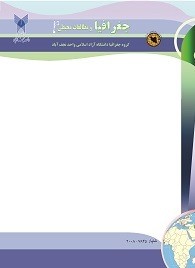پیشبینی تغییرات مورفولوژی رودخانه سفید رود با استفاده از Arc GIS
محورهای موضوعی : GIS
عقیل مددی
1
,
طیبه بابایی اولم
2
![]() ,
علیرضا قدرتی
3
,
علیرضا قدرتی
3
![]()
1 - استاد، گروه جغرافیای طبیعی، دانشگاه محقق اردبیلی، اردبیل، ایران.
2 - دانشجوی دکتری، گروه جغرافیای طبیعی، دانشگاه محقق اردبیلی، اردبیل، ایران.
3 - بخش تحقیقات جنگلها، مراتع و آبخیزداری، مرکز تحقیقات کشاورزی و منابع طبیعی استان گیلان، سازمان تحقیقات، آموزش و ترویج کشاورزی، رشت، ایران.
کلید واژه: زنجیره مارکف, سفیدرود, مدل سلولهای اتوماتیک, مطالعات سنجش از دور,
چکیده مقاله :
با توجه به رویدادهای سیل بهویژه برای سکونتگاهها پیرامون رودخانهها، عدم اطلاع صحیح از تغییرات متوالی بستر رودخانه و جابجایی آن در سالهای آتی یکی از مسایل مهم علمی آبخیزداری میباشد از اینرو به دلیل اطلاعات ناکافی از رفتار رودخانهها، سکونتگاههای حاشیه رودخانههای مناطق ساحلی دائماً دچار آسیب هستند. محدوده مورد بررسی این تتحقیق از مرز کنیک کوهستان تا جلگه میباشد. هدف از این پژوهش پیشبینی تغییرات مورفولوژی رودخانه (عرض کانال و اندازهگیری پیچانرودی و ضریب خمیدگی رودخانه) در مناطق ساحلی شمال کشور از طریق روشهای تلفیقی سنجش از دور با مدل سلولهای اتوماتیک وزنجیره مارکوف است. سفیدرود به عنوان بزرگترین و مهمترین رودخانه سواحل جنوب دریای خزر نقش مهمی در زندگی، فعالیتها و سرمایههای انسانی منطقه دارد. عوامل مورفولوژیک رودخانه و محیطهای پیرامون آن و پیشبینی شرایط آینده میتواند در برنامهریزی و آمایش دشتهای ساحلی موثر و ضروری واقع شود. در این پژوهش از تصاویر ماهوارهای لندست 5، 7 و 8 سالهای، 2002،1987 و 2018، همراه با دادههای تغییرات تراز دریای خزر و دبی سفیدرود، بررسیهای میدانی و نرم افزارهای Envi 5.3، ArcGIS 10.4.1 و Idrisi TerrSet به عنوان ابزار تحقیق بهره گرفته شد. ابتدا مقادیر احتمال تبدیل کاربری اراضی در سال 2018 بر مبنای مدل تلفیقی زنجیره مارکوف و سلولهای خودکار بهدست آمد. نتایج نشان داد که مدل تلفیقی، دارای دقت و صحت بالایی جهت پیشبینی الگوی آینده است. سپس با توجه به دقت و صحت خروجی مدل، نقشه پیشبینی کاربری اراضی و مورفولوژی رودخانه برای سال 2030 تهیه شد. با برازش دو نقشه سال 2018 و پیشبینی 2030 تغییرات محتمل در محیط رودخانه بهدست آمد و در چهار محدوده مورد تحلیل قرار گرفت. در نهایت با استفاده از دادههای تغییرات تراز دریای خزر و دبی سالانه رودخانه سفیدرود، روند تغییرات و پیشبینی مدل، مورد بررسی قرار گرفت. بیشترین احتمال تغییرات بر اثر تاسیسات ساخت انسان میباشد. فرایندهای فرسایشی، تغییر پیچانرودی و سیلگیری در حد فاصل سد سنگر تا روستای لومان بصورت جابجایی جانبی کانال و تشدید پیچانرودی، روستای کیسم و شهر آستانه اشرفیه و آزادسرا تا لیچاه بصورت سیلگیری تاسیسات انسانی و در محدوده کیاشهر، تالاب بوجاق و دلتای سفیدرود بصورت تغییر موقعیت مصب و جابجایی به غرب کانال رودخانه میباشد، با توجه به نتایج بررسی مقطع عرضی کانال رودخانه در سه دوره 1987، 2002 و 2018، روند کاهشی عرض کانال رخ داده است.
Considering the flood events, especially for the settlements around the rivers, the lack of correct information about the consecutive changes of the river bed and its movement in the coming years is one of the important scientific issues of watershed management, therefore, due to insufficient information about the behavior of the rivers, the settlements along the rivers in the coastal areas are constantly damaged. The scope of this research is from the border of Konik Kohestan to Jalga. The purpose of this research is to predict the changes in river morphology (channel width and measurement of Pichanroudi and river curvature coefficient) in the coastal areas of the north of the country through the integrated methods of remote sensing with the model of Markov automatic weighing cells. Sefidroud, as the largest and most important river on the southern shores of the Caspian Sea, plays an important role in the life, activities and human capital of the region. The morphological factors of the river and its surroundings and the prediction of future conditions can be effective and necessary in the planning and preparation of coastal plains. In this research, the Landsat 5, 7 and 8 satellite images of 2002, 1987 and 2018, along with the data of changes in the level of the Caspian Sea and Sefidroud Dubai, field surveys and Envi 5.3, ArcGIS 10.4.1 and Idrisi TerrSet software as The research tool was used. First, the probability values of land use conversion in 2018 were obtained based on the integrated model of the Markov chain and automatic cells. The results showed that the integrated model has high precision and accuracy to predict the future pattern. Then, according to the accuracy and accuracy of the model output, the prediction map of land use and river morphology for 2030 was prepared. By fitting the two maps of 2018 and the forecast of 2030, possible changes in the river environment were obtained and analyzed in four areas. Finally, using the data of changes in the level of the Caspian Sea and the annual discharge of the Sefidroud River, the trend of changes and prediction of the model was investigated. The most likely changes are due to man-made facilities. Erosion processes, change of Pichanroodi and flooding in the distance from Sangar Dam to Luman village as lateral displacement of the channel and intensification of Pichanroodi, Kisem village and the city of Astana Ashrafieh and Azadsara to Lichah as flooding of human facilities and in the area of Kiashahr, Bojag wetland and delta Sefidroud is changing the position of the estuary and moving to the west of the river channel, according to the results of the survey of the cross section of the river channel in the three periods of 1987, 2002 and 2018, there has been a decrease in the width of the channel.


